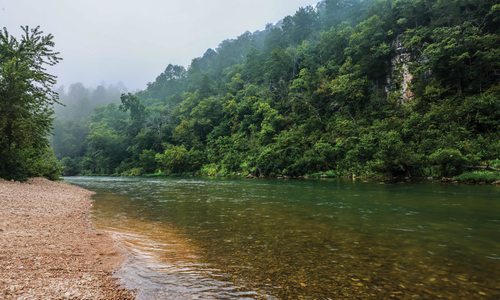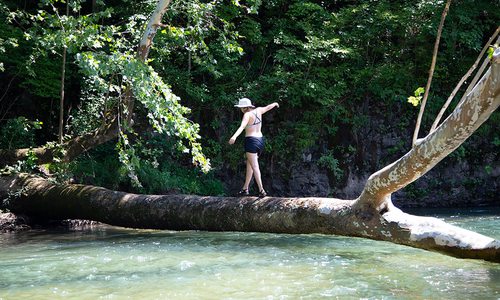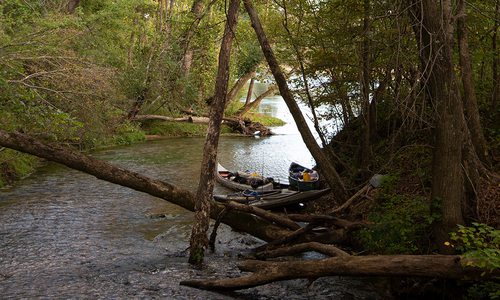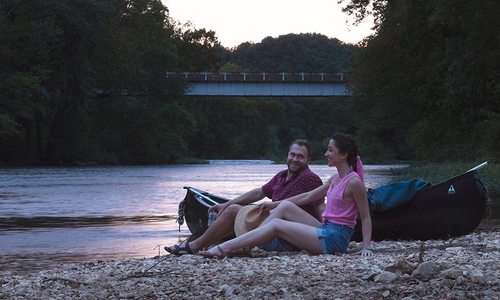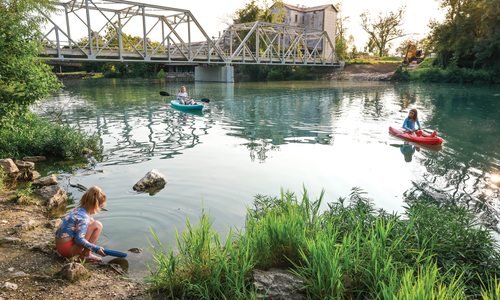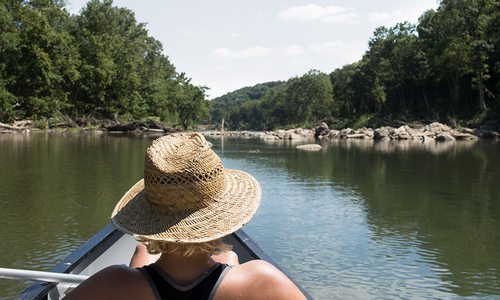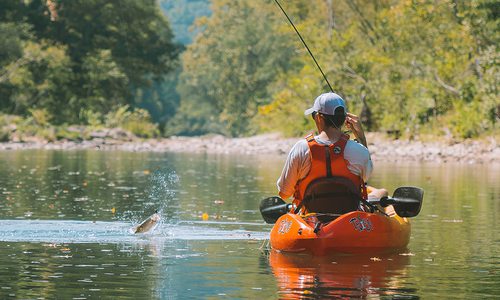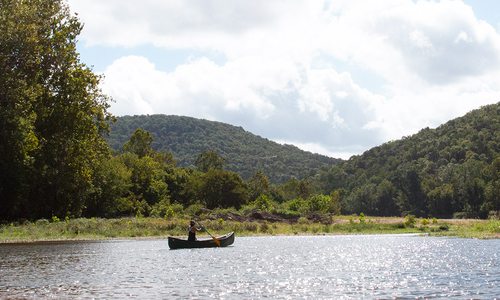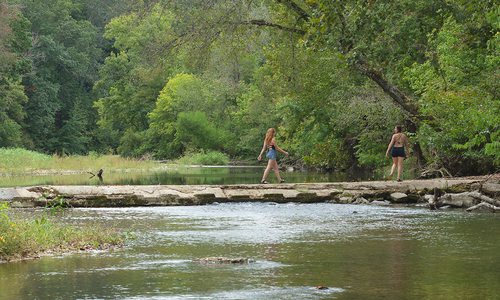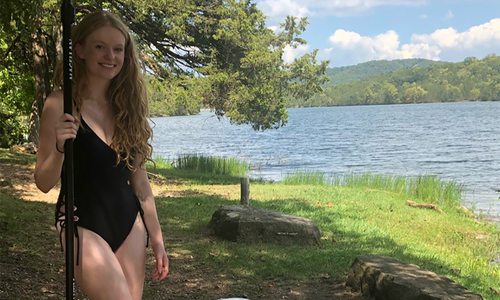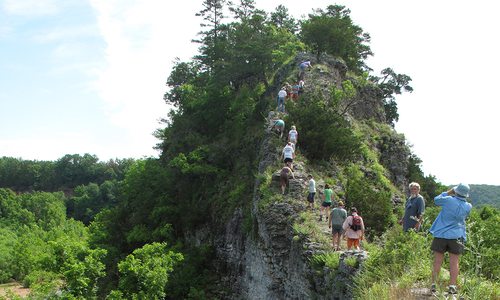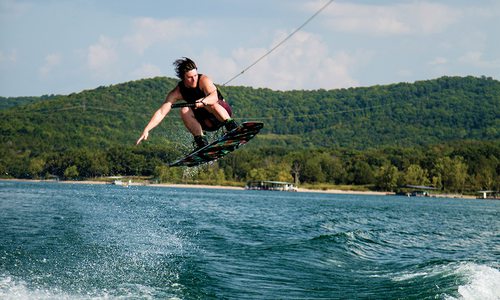Waterways
Best Float Trips in the Ozarks
Learn why our rivers are such a vital part of southwest Missouri's landscape, and explore scenic float trips that can only be enjoyed in the Ozarks.
By Sony Hocklander
Jun 2024
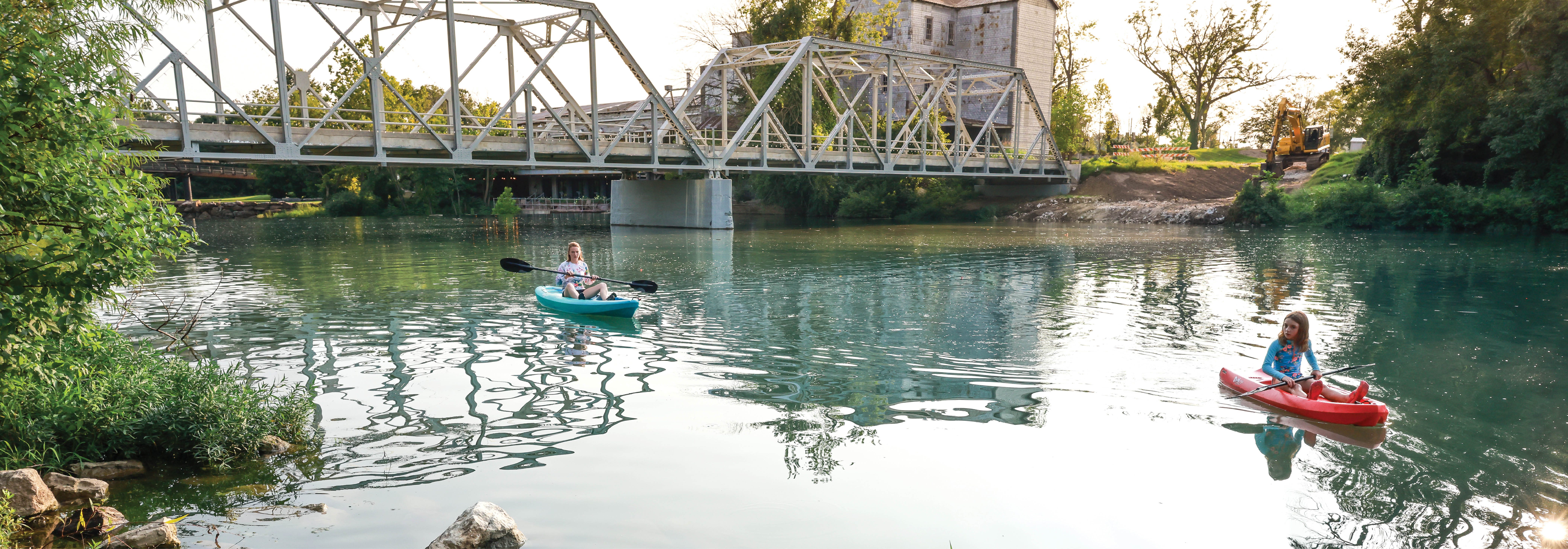
Jump to A Section
If you live in southwest Missouri, you live near a river. And that’s something to celebrate. Ozarks waterways shaped the land where we live, work and play, and our way of life would look very different without them. That’s especially true for people who enjoy spending time outdoors, and for those whose livelihoods are linked with outdoor tourism.
Rivers have always been crucial to life in the Ozarks, says Mike Kromrey, executive director of the Watershed Committee of the Ozarks located at Valley Water Mill Park.
Indigenous people, early settlers and explorers like Henry Rowe Schoolcraft were drawn to Ozarks streams for access to drinking, growing crops, running grist mills and transportation. And while public use leans more recreational now, “economically speaking, they’re still tremendously important,” he says.
Not only do rivers and lakes provide natural places to swim, fish, boat and float, the outdoor tourism dollars they generate are an economic boon. For instance, the Missouri Department of Conservation estimates trout fishing and related activities contribute $382 million to our state each year. Roaring River, Bennett Spring and Montauk state parks—three spring-dependent trout parks in the Ozarks—saw nearly 3 million visitors in 2023. That doesn’t include anglers casting for trout and other fish in nearby rivers and lakes.
In addition to their economic and recreational benefits, a river is a place to find peace and balance: “Rivers have healing and grounding power,” says Kromrey, an outdoor enthusiast and longtime advocate for clean water, healthy rivers and conservation practices. “I haven’t met a single person who doesn’t love the river.”
For all those reasons and more, spending time at a river is an Ozarks tradition. For one thing, people who live in urban areas yearn for green space, fresh air and natural resources, says Dena Matteson, Chief of Interpretation, Planning and Partnerships for the Ozark National Scenic Riverways. And it becomes a generational thing.
“If you are somebody whose family came [to the Scenic Riverways] when you were a child, it’s probably because your parents came with their parents,” Matteson says. Year after year, “we see families that have close personal ties and feel that this is their river, no matter where they come from.”
Lifeblood of the Ozarks
Small boats motor up and down along the White River near Mountain Home, Arkansas, occasionally passing a kayak or an angler on the bank. The river is wider here than its floatable tributaries, and swift as it rushes past picturesque wooded bluffs, small pools and shoals, remote homes and small river communities. It’s truly a trout-fishing paradise.
Altogether, the White River snakes 720 miles through Arkansas and into southern Missouri, its flow disrupted by eight primary dams and their resulting lakes including the border-straddling Bull Shoals and Table Rock, plus Lake Taneycomo in 417-land.
No body of water has had as much impact on the Ozarks as the White River, says Ozarks historian Dr. Brooks Blevins, a professor at Missouri State University who hails from Arkansas. It’s the biggest river that originates in the Ozarks and it flows through its heart, he says.
“I’ve always considered the White River the lifeblood of the Ozarks,” he says. “From an economic standpoint, from a settlement standpoint, from a cultural history standpoint.
The importance of Branson tourism and the kind of central role the river and its tributaries like the James River play. Today, your most visited lakes—outside Lake of the Ozarks which is a completely different animal—are in the White River Watershed.”
Dams and Recreation
For more than 100 years, Ozarkers have tried to tame the White River. Because of frequent flooding and the need for electric power, the river’s first dam—Powersite in Forsyth—was built and operational by 1913. Wrangling the river and its North Fork tributary with hydroelectric dams continued through the 1960s, producing Table Rock, Bull Shoals, Beaver, Norfork and other lakes. That ushered in entertainment, especially around Branson.
The Bull Shoals Dam certainly changed the landscape and how the waterway was used in Arkansas, says Jackie Rupp, an interpreter with the Division of Arkansas State Parks at the Bull Shoals-White River State Park two hours south of Springfield. “This was a great area to fish for small mouth bass,” Rupp says, “but when they built the dam—because it pulls the water for generation from the bottom of the lake—it’s super cold water. Bass cannot live there. So the Arkansas Game and Fish Commission started stocking trout, which is a big sport fish. Folks come to fish for trout here at the park and all along the White River.”
Waterway recreation didn’t originate with dams and lakes, Blevins says. “The real recreation industry on Ozarks rivers starts in the late 1800s. And the White River would have been the premier destination for that, and its tributaries. What I’m talking about is, really, the early version of what we call a float trip,” he says. Today’s floats are typically paddle adventures in kayaks and canoes. But in the late 19th and early 20th centuries, a float trip meant a multi-day fishing excursion in a flat-bottomed Ozark johnboat with a guide, typically employed by affluent or upper- middle-class men from urban areas including Springfield, St. Louis and Kansas City. By the early 1900s, johnboat tourism had become Branson’s “calling card,” Blevins says.
Johnboat floats ended when the White River near Branson was swallowed up by dam-formed lakes, but Branson’s reputation for tourism endured.
Preserving Wild Rivers
Similar johnboat floats were happening on tributaries of the White, Blevins says, evolving into the float and fishing trips we enjoy today on the watershed’s federally protected wild rivers, so designated as a result of the national environmental movement of the 1960s.
Recreation at wild rivers ticked up after August 24, 1964, when 134 miles of the free-flowing spring-fed Current River and its tributary, the Jacks Fork, became the first federally protected river system known as the Ozark National Scenic Riverways. The movement also led to the National Wild and Scenic Rivers Act of 1968—extended to the nearby Eleven Point River, which is managed by the U.S. Forest Service—and the designation in 1972 of the Buffalo River as America’s first national river. All four wild streams are part of the White River Watershed.
If not for federal management of the Current and Jacks Fork, says Matteson with the National Park Service, you might be floating by man-made “intrusions,” such as public and private homes and buildings instead of wilderness and woods. Or like the White River, the Current and the Jacks may have been dammed. The Buffalo National River was tapped for such a fate before it was saved. “Of course reservoirs have their place and they’re wonderful recreation areas, and provide different things to our lives,” Matteson says. But preserving these rivers in their natural state, unmarked by damming, also preserves their cultural and historic significance to the southern part of Missouri, she says. NPS management of land around the Scenic Riverways—with the exception of two-mile gaps before and after the towns of Eminence and Van Buren—also ensures conservation practices protect intricate cave and spring systems. “This is a world-class spring system, unequaled anywhere else in North America. And it’s one of the highest densities of caves in any natural park in the country. The springs feed these rivers. That they’re available for the public to enjoy today is a wonderful benefit of having these two rivers preserved.”
Fishing Ozarks streams evolved, too. Not native to the Ozarks, trout were introduced to local waters in the late 1800s, and angling for trout has since become a strong outdoor industry. Over time, trout have propagated in wild streams too, with the best sections designated as Blue Ribbon Trout Areas.
Local Stewardship
Federal designation isn’t the only way to protect Ozarks rivers. It’s important we all do our part to help keep them clean and healthy. Our actions make a difference, especially for the nearby James and Little Sac rivers. “We get a lot of our drinking water from the James and a lot more of it from the Little Sac River, which is captured at Fellows Lake and McDaniel Lake, and then brought back from Stockton Lake—all part of the Little Sac system,” Kromrey says.
Whether you prefer to cast a line, dip a paddle, or simply gaze at our rivers, their health should matter to all of us. That’s why the Watershed Committee and other area nonprofits focus on education, civic action and measuring river quality. “There are over 40 species of fish that are indigenous or that live in Ozarks streams,” Kromrey says. “And they’re supported by a whole community of macro-invertebrates—aquatic insects and crayfish. We can use an assessment of what’s living in the stream to gauge how healthy the stream is.”
That health improves when communities care. That’s why it’s important to advocate for our waterways and encourage community members to feel ownership and stewardship. Add native plants to your garden. Reduce erosion. Support greenways. Dispose of chemicals responsibly.
“It’s less about what you do when you’re on the river,” Kromrey says, “and more about knowing that the river truly starts right in all of our backyards.”

Sony Hocklander is a journalist, photographer, editor and video producer with a 25-year history of storytelling in the Ozarks and a passion for the outdoors. Following a variety of positions with the Springfield News-Leader including writing, editing and magazine design, in 2016 she established Sony Hocklander Creative, LLC. Through her freelance business, Sony has produced a variety of content for local nonprofits and media outlets: marketing and education videos; event and editorial photography; and feature, business and outdoor freelance writing. Today she focuses solely on outdoor travel writing and photography for 417 Magazine and other regional media outlets; and on printed outdoor photo art for showcase and display.
Tips For Those New to Floating
by Vivian Wheeler
Get your feet wet with these resources for floating newbies.
Learning the Ropes
If you’re looking to learn the basics of floating, check out the Ozark Mountain Paddlers. This nonprofit holds a number of recreational canoe and kayak clinics throughout the summer. For details, visit their website.
Practice Makes Perfect
If you want to practice before heading out on the river, rent a canoe or kayak from the Lake Springfield Park and Boathouse. Lake Springfield is a calm, relaxed environment where you can develop your river legs.
Get the Gear
Wanting to purchase your own gear? Both Bass Pro Shops and Ozark Adventures carry anything you might need to get river-ready.
Try Something New
by Vivian Wheeler
We’ve rounded up float trip options that offer a little something different.
Float After Dark
The Outdoor Initiatives branch of the Springfield–Greene County Park Board offers two overnight floats each year. Enjoy a guided float and experience the outdoors in a whole new (lack of) light. These trips typically happen in June and August. Details are at parkboard.org.
Two-Day Overnight Float
Depending on rainfall you might have missed it this year, but one of the coolest, most scenic stretches of any river in Missouri and Arkansas is only floatable in early spring. The upper section of the Jack’s Fork River is said to have more beautiful bluffs than even the Buffalo River. See what the fuss is about on a two-day float running from Buck Hollow Access to Bay Creek. This trip is not recommended for inexperienced floaters.
Paddle and Sip
Throughout the months of May and June, 37 North Expeditions offers several trips that pair floating with a brewery or distillery tour.
Floating Do's and Don'ts
by Vivian Wheeler
What you need to know before you start to float down river.
Always check the water level. If the water is too high, floating can be dangerous. If it’s too low, you might not be able to float. Due to rain, rivers can vary wildly day-to-day.
Wear sunscreen. Missouri summers can be brutal, and you don’t want to be stuck on a multi-hour float without proper protection from the sun.
Littering is illegal. Secure your trash in a trash bag that is tied to your canoe in case you tip over. You don’t want to spill your garbage all over the river.
Glass bottles are illegal on all rivers. It’s illegal to have them in your boat or on a gravel bar. If you’re caught with glass bottles, you could face a hefty fine for each bottle in your possession.
Wear water shoes for wading. Need we say more?
If you do tip, move to the upstream side of your canoe to avoid being trapped between your boat and an obstacle.
Reserve your boat ahead of time. On popular weekends, outfitters can book up. Pay attention to the reservation policy. Some outfitters require advance cancellation to get your deposit back.









